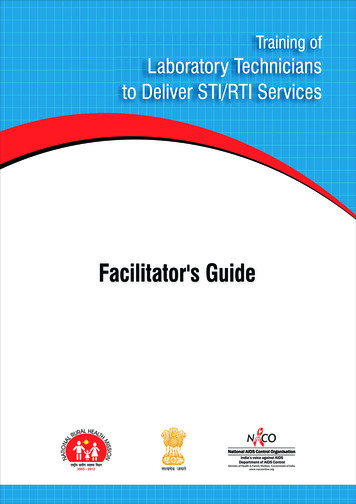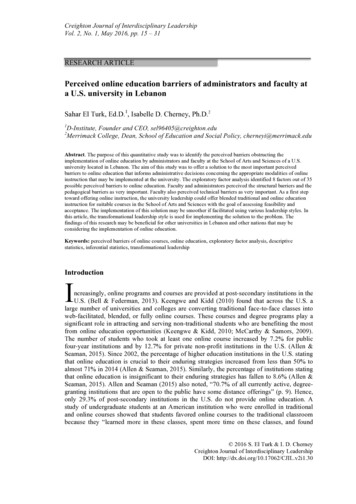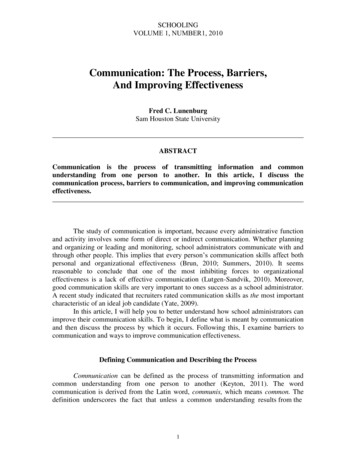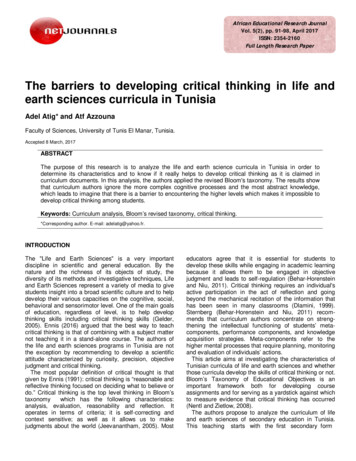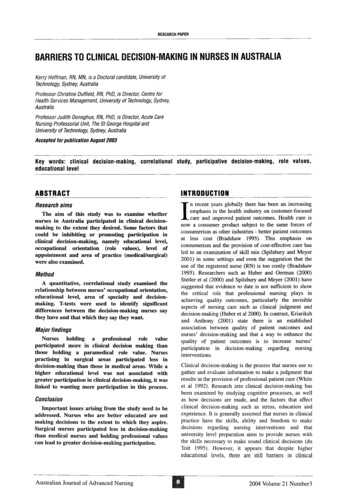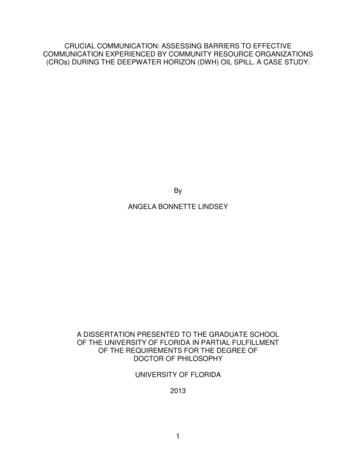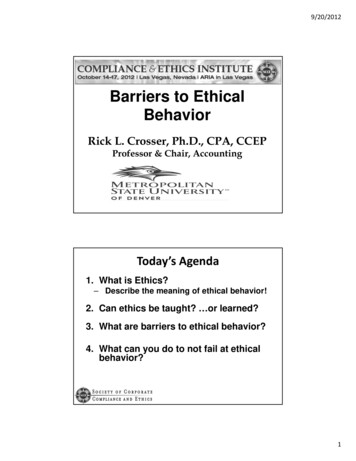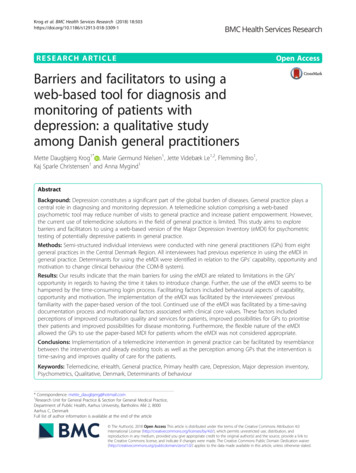
Transcription
Krog et al. BMC Health Services Research (2018) EARCH ARTICLEOpen AccessBarriers and facilitators to using aweb-based tool for diagnosis andmonitoring of patients withdepression: a qualitative studyamong Danish general practitionersMette Daugbjerg Krog1* , Marie Germund Nielsen1, Jette Videbæk Le1,2, Flemming Bro1,Kaj Sparle Christensen1 and Anna Mygind1AbstractBackground: Depression constitutes a significant part of the global burden of diseases. General practice plays acentral role in diagnosing and monitoring depression. A telemedicine solution comprising a web-basedpsychometric tool may reduce number of visits to general practice and increase patient empowerment. However,the current use of telemedicine solutions in the field of general practice is limited. This study aims to explorebarriers and facilitators to using a web-based version of the Major Depression Inventory (eMDI) for psychometrictesting of potentially depressive patients in general practice.Methods: Semi-structured individual interviews were conducted with nine general practitioners (GPs) from eightgeneral practices in the Central Denmark Region. All interviewees had previous experience in using the eMDI ingeneral practice. Determinants for using the eMDI were identified in relation to the GPs’ capability, opportunity andmotivation to change clinical behaviour (the COM-B system).Results: Our results indicate that the main barriers for using the eMDI are related to limitations in the GPs’opportunity in regards to having the time it takes to introduce change. Further, the use of the eMDI seems to behampered by the time-consuming login process. Facilitating factors included behavioural aspects of capability,opportunity and motivation. The implementation of the eMDI was facilitated by the interviewees’ previousfamiliarity with the paper-based version of the tool. Continued use of the eMDI was facilitated by a time-savingdocumentation process and motivational factors associated with clinical core values. These factors includedperceptions of improved consultation quality and services for patients, improved possibilities for GPs to prioritisetheir patients and improved possibilities for disease monitoring. Furthermore, the flexible nature of the eMDIallowed the GPs to use the paper-based MDI for patients whom the eMDI was not considered appropriate.Conclusions: Implementation of a telemedicine intervention in general practice can be facilitated by resemblancebetween the intervention and already existing tools as well as the perception among GPs that the intervention istime-saving and improves quality of care for the patients.Keywords: Telemedicine, eHealth, General practice, Primary health care, Depression, Major depression inventory,Psychometrics, Qualitative, Denmark, Determinants of behaviour* Correspondence: mette daugbjerg@hotmail.com1Research Unit for General Practice & Section for General Medical Practice,Department of Public Health, Aarhus University, Bartholins Allé 2, 8000Aarhus C, DenmarkFull list of author information is available at the end of the article The Author(s). 2018 Open Access This article is distributed under the terms of the Creative Commons Attribution 4.0International License (http://creativecommons.org/licenses/by/4.0/), which permits unrestricted use, distribution, andreproduction in any medium, provided you give appropriate credit to the original author(s) and the source, provide a link tothe Creative Commons license, and indicate if changes were made. The Creative Commons Public Domain Dedication o/1.0/) applies to the data made available in this article, unless otherwise stated.
Krog et al. BMC Health Services Research (2018) 18:503BackgroundThe global burden of mental diseases is increasing.Depression is currently the most common mental disorder, affecting approximately 300 million people worldwide according to the World Health Organization [1].General practice plays a central role in the diagnosis andmonitoring of depression [2, 3], and many general practitioners (GPs) use psychometric tools for assessment.A range of rating scales and psychometric tools areused by GPs worldwide for diagnosis and monitoring ofdepression [4]. The most frequently used tool inDenmark is the Major Depression Inventory (MDI), andDanish GPs are remunerated for undertaking psychometric testing [2]. The MDI is a self-report questionnaire in which the patient scores the frequency of his orher symptoms during the last 2 weeks [4]. It explores theICD-10 criteria for depression in a questionnaire form.On the basis of the patient’s individual symptom score,the GP calculates an overall MDI summary score, whichserves as a measure of depression severity (mild, moderateor severe) and for monitoring changes over time.Telemedicine has been introduced as a new tool to meetthe current challenges of the increasing prevalence of depression and chronic diseases [5] and has become a political priority worldwide [6]. Telemedicine is a conceptaround which many different definitions prevail. As a result, the WHO has adopted the following broad definitionof telemedicine, which we subscribe to in our study:Page 2 of 9record. The content in the paper-based MDI and theeMDI is identical, and the GP can freely choose betweenthe two.When the eMDI was launched, it was expected to replace the paper-based MDI and save visits to the GP [10].The eMDI has, however, so far not been implemented tothe extent that was originally expected, and the reasonsbehind have not been systematically explored. This is thecase for many new telemedicine initiatives [6].Theoretical frameThe Behaviour Change Wheel offers a comprehensivestructured framework for guiding the design and evaluation of interventions and is based on the COM-Bmodel [11]. COM stands for the three behavioural factors Capability, Opportunity and Motivation, whereas Bis short for Behaviour. Capability is understood as skills,strength, stamina (both physical and mental) andknowledge. Opportunity involves factors outside the individual (time, organizational structures, legislation, etc.).Motivation can be reflective (goals, values and consciousdecision-making) or automatic (emotional response andhabitual processes) [11]. The COM-B analysis aims to explore how a specific behaviour is influenced by theCOM-B factors, thereby revealing how behaviour is promoted or impeded by the individual’s capabilities, opportunities and motivation.Aim of the study“The delivery of health care services, where distance isa critical factor, by all health care professionals usinginformation and communication technologies for theexchange of valid information for diagnosis, treatmentand prevention of disease and injuries, research andevaluation, and for the continuing education of healthcare providers, all in the interests of advancing thehealth of individuals and their communities” [6].This study aims to explore facilitators and barriers tousing the eMDI in psychometric testing of patients withsymptoms of depression in Danish general practice bygaining insight into the behaviour of GPs who use thetool and factors affecting their behaviour in terms ofcapability, opportunity and motivation.MethodsDesignThe implementation of telemedicine on a wider scalehas been suggested as a way to reduce the number ofhealthcare visits and provide empowerment of patients.Despite great expectations, clear evidence of economicbenefits of telemedicine is lacking, e.g. due to limitedimplementation of large-scale projects [6–8].To increase the use of a specific telemedicine tool(WebPatient) in Danish general practice, the DanishMinistry of Health launched a new initiative in 2015aiming to implement WebPatient in Danish generalpractice over a three-year period [9]. In this system, theGP can request different web-based tests including theeMDI. The requested test is sent to the patient’s mailboxthrough an electronic link with a following electronic instruction on how to fill it in. The overall score is thenautomatically returned to the GP’s electronic patientWe conducted a qualitative study by performingsemi-structured individual interviews with GPs to explore their views on and experiences with the eMDI.RecruitmentTo include GPs with sufficient experience of using theeMDI, we adopted a purposeful sampling strategy [12]applying the inclusion criterion that interviewees mustbe current users of the eMDI. We made use of information about their current use of the eMDI from MedCom(a non-profit organization, which monitors the use ofeMDIs by each Danish general practice in WebPatient)to ensure that only GPs from practices with significantusage were invited. We invited 35 GPs from theseMedCom lists. Additionally, we invited 15GPs fromdevelopment practices (i.e. practices participating in
Krog et al. BMC Health Services Research (2018) 18:503small-scale pilot-testing of quality development projectsbefore large-scale implementation) in the CentralDenmark Region [13].During February and March 2017, a total of nine interviewees were recruited (six recruited from MedCom listsand three from development practices) (Table 1). Six interviewees were male, and three were female. The age ofthe interviewees ranged from 44 to 67 years. Eightinterviewees worked in partnership practices, and oneworked in a solo practice.Data collectionInterviews were conducted in March and April 2017 in asetting chosen by the interviewees. Seven interviewstook place in the interviewee’s own clinic, and two interviewees preferred a telephone interview.The semi-structured interview guide included questions about the interviewees’ specific behaviour, suchas how, when and for whom they use the web-basedeMDI. Questions were related to aspects of capability, opportunity and motivation as well as the interviewees’ general experiences of problems with andbenefits of using the eMDI in their daily work(Table 2). The interview guide was tested by performing pilot interviews with two GPs who were experienced users of the eMDI but were not enrolledin the study.All interviews were recorded and transcribed verbatim, and additional field notes were written downimmediately after each interview. As a means to secure validity of the interviews, refine the interviewguide and to increase information power [14], MDKand AM continuously discussed transcripts duringdata collection. Sampling ceased when new barriersand facilitators stopped emerging and we found tohave enough information to adequately answer the research question. The interviews lasted 20–60 minwith an average length of 45 min.Table 1 Overview of intervieweesIntervieweeAge (years)Working experience ingeneral practice (years)I150–59 25I260–69 30I340–49 5I440–49 10I540–49 5I650–59 15I750–59 10I850–59 10I960–69 15Page 3 of 9Analytical procedureFollowing the hermeneutic approach [15], the analysisswitched between looking at the full interview as a singlemeaningful unit and at smaller units of meaning within thetext. First, the transcripts were read thoroughly by MDK toget an overall impression of the material. Meaningful unitswere identified and coded thematically in accordance tothe components in the COM-B model. This initial thematic coding was conducted by MDK and AM. The codingprocess was discussed in the research group consisting ofgeneral practitioners (FB, KSC), researchers with experience in the field of telemedicine (MDK, KSC, MGN),qualitative methods (MDK, FB, AM, JVL) and applicationof the COM-B model for research purposes (FB, JVL,AM). This iterative process led to agreement on the mostimportant sub-themes within the components of theCOM-B model. These sub-themes were further classifiedas either barriers or facilitators for the use of the eMDI.Throughout the analysis, the researchers’ preunderstandings were challenged by switching betweenopen and focused coding of data. Thus, the three behavioural components capability, opportunity and motivationformed the basis of the focused coding process, whilesub-themes emerged more freely through open coding.Data were analysed using NVivo 11 [16].ResultsThe interviewees have different experiences with the useof the eMDI in daily clinical practice. Variations includethe extent to which the eMDI has become part of theirday-to-day routine and how, when and for whom theeMDI is used. Table 3 shows an overview of the identifiedfacilitators and barriers for the use of the eMDI, as theyemerged from the analysis. The most dominant themes,emerging in all or most interviews, are also presented.The barriers and perceived facilitators related to the useof the eMDI will be described in the following with reference to the three behavioural components of the COM-Bmodel: capability, opportunity and motivation. It will beemphasized whether and how elements belonging to thethree components occur as barriers or facilitators inreaching the target behaviour, understood as use of theeMDI. When relevant, a distinction will be made betweenbehaviour in relation to diagnostics and monitoring.CapabilityFamiliarity with the paper-based MDIMany of the interviewees mention similarity betweenthe traditional paper-based MDI and the eMDI as a facilitator in the implementation of the eMDI. A frequentuser of the eMDI explains:“If you had to start from scratch on both the electronicpart and the form itself, it would have been more
Krog et al. BMC Health Services Research (2018) 18:503Page 4 of 9Table 2 Overview of interview guideBehavioural factorThemeSub-themeExample of probing questionCapabilityPsychological capabilityTechnical skills in relation to the eMDIDid you feel confident in using the electronic form whenusing it for the first time? Was it difficult? Easy? Do youfeel more confident when using it now?OpportunitySocial opportunityOrganisational settingCan you describe the process of implementing the eMDIin your practice? How did you get started as a practice?Physical opportunityAspects of time and resources in the clinicHow would you describe the settings and opportunities forembedding the eMDI here in your practice? Which challengeshave you experienced? Which do you still experience?Reflective motivationFeelings of autonomy and competence inusing the eMDIWhen you first started using the eMDI, did you feel that itwas imposed on you? Or did you start using it out of yourown interest? Did you feel confident about using the eMDI?ValuesWhich pros and cons of the eMDI do you see ascompared to the paper-based version?Which considerations do you take into account whenchoosing between the two?Has the eMDI in any way influenced the relationship withyour patient?Attitude towards telemedicineHow do you feel about the increasing use of telemedicinein general practice?Prioritising toolFor whom and when do you typically use the eMDI? Andthe paper-based MDI?Habits and routinisationHow often do you use the eMDI instead of the paper-basedMDI? What could make you choose the eMDI even morefrequently?MotivationAutomatic motivationdifficult. But as it’s a natural development, I think itwas quite ( ), I don’t think it was difficult.” (I1).Because it’s about something else, it could be that youare insecure in another way.” (I8).Another interviewee agrees and hypothesises that inexperience with using the MDI might hamper the routine use of the eMDI:She elaborates on how her previous experience with theMDI has made the transition from the paper version tothe electronic version easier. Previous experience with theMDI thus appears to serve as a facilitator in the process ofembedding the eMDI into the GPs’ daily routines.“Then it’s like: ‘Am I doing it right? Do I interpret it inthe right way?’. And then you might end up beingcritical about it. And in my opinion that’s wrong.Table 3 Facilitators and barriers emerging from the analysisFacilitatorsCOM-B componentSub-themeCapabilityFamiliarity with the paper-based MDIaOpportunityEasy documentation processaMotivationNot fewer, but better consultationsaMotivationImproved services for patientsMotivationImproved prioritisation between patientsMotivationImproved patient monitoringaMotivationFlexible use for selected patientsBarriersaCOM-B componentSub-themeOpportunityResource demanding introduction of changeaOpportunityTime-consuming login to the systemThemes emerging in most or all interviewsOpportunityEasy documentation processAll interviewees perceived the eMDI as a timesaver compared to the paper version since the latter requires printing, scanning and entering the results from the formsinto the laboratory system of the clinic. Thus, they explain how the introduction of the eMDI has made theprocess of documenting the patients’ scores easier. Formany of the interviewees, this was a significant facilitator in their use of the eMDI.Resource demanding introduction of changeEven though the eMDI gives the interviewees more timefor other tasks, it also takes time to change one’s routines. The interviewee who uses the eMDI the least expresses this duality:“If you want change to happen sooner and more[efficiently], then you have to hire twice as many GPsso we won’t be as busy as we are now because from
Krog et al. BMC Health Services Research (2018) 18:503when we walk into our clinic in the morning and untilwe leave again, we usually work like little beasts. Andthen it’s just, then you draw on your routines. So ittakes time to create change.” (I4).The extra effort that it takes to change routines acts asa significant barrier in the introduction of change. As areflection of this, the interviewees have embedded theuse of the eMDI into their daily routines at various degrees. One interviewee who rarely uses the paper formanymore says the following about choosing the eMDI:“It has become an ingrained part of my routines [ ]So it’s a natural part of my routines now. So frombeing something I remembered to use a lot of the timein the beginning, it is now entirely what I use.” (I7).This quote describes what happens when behaviourchanges from being something you make yourself dointo something you just do.Page 5 of 9patient. Thus, every completed form, both thepaper-based and the web-based version, is followed by aconsultation. Only in a few cases (if the patient is in recovery or has a low MDI score), the interviewees replace theface-to-face consultation with an e-mail or a telephoneconsultation.Furthermore, the personal contact and dialogue between GP and patient is an essential value for the interviewees. One interviewee, who is generally worriedabout the increasing number of forms and figures ingeneral practice, sees greater advantages in the eMDIcompared to the paper-based MDI because the eMDI releases time in the consultation. When one of the interviewees is asked if the number of visits by patients withdepression has changed since he started using WebPatient, he reflects:“When it comes to people with depression, the number[of visits] is the same, but one could imagine that itwould be possible to save some visits when it comes tocontrols of blood pressure. But not with depression.” (I5).Time-consuming login to the systemAll interviewees agree that the eMDI is easy to use, andthey experience no challenges in meeting the technicalcapabilities required, which is partly due to their familiarity with using web-based laboratory tests as an integrated part of their daily work. Despite this familiarity,some of the interviewees experience a barrier in thetime-consuming process of logging on to the patient’saccount during the consultation. The login process requires the patient to enter his or her social securitynumber, a password and then a specific numbercodecombination. One interviewee explains why he does notuse the eMDI for the patients he assesses to be unableto fill it in at home:“It would require the patient to log on to the system withNemID [Danish online login solution] during theconsultation. Then half of the consultation wo
May 14, 2017 · monitoring of depression [2, 3], and many general prac-titioners (GPs) use psychometric tools for assessment. A range of rating scales and psychometric tools are used by GPs worldwide for diagnosis and monitoring of depression [4]. The most frequently used tool


